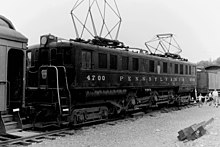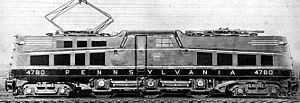PRR class P5
| Pennsylvania Railroad P5, P5a, and P5b | |
|---|---|
|
PRR P5a 4780 in the streamlined modified version
|
|
| Numbering: | P5: until 1933: 7898–7898 from 1933: 4700, 4791 P5a: 4701-4790 |
| Number: | P5: 2 P5a: 90 P5b: 1 (converted P5a) |
| Manufacturer: | PRR Altoona Works Baldwin Westinghouse GE |
| Year of construction (s): | P5: 1931 P5a: 1931-1935 P5b: 1937 |
| Retirement: | 1960s |
| Axis formula : | P5, P5a: 2'Co2 ' P5b: Bo'CoBo' |
| Gauge : | 1435 mm ( standard gauge ) |
| Length over coupling: | 19,100 mm (62 ft 8 in ) |
| Service mass: | P5, P5a Boxcab : 178 t P5a Modified : 179 t P5b: 201.7 t |
| Wheel set mass : | P5, P5a Boxcab : 34 t P5a Modified : 35 t P5b: 35.3 t |
| Top speed: |
Depending on gearbox: Passenger train ratio: 145 km / h (90 mph) Freight train ratio: 113 km / h (70 mph) |
| Short term output: |
P5, P5a: 4850 kW (6500 hp) |
| Continuous output : |
P5, P5a: 2800 kW (3750 hp) P5b: 3910 kW (5250 hp) |
| Continuous tensile force: |
Depending on the gearbox: Passenger train ratio: 100 kN at 100 km / h Freight train ratio: 128 kN at 80 km / h |
| Driving wheel diameter: | 1830 mm (72 in) |
| Power system : | 11 kV 25 Hz alternating current |
| Number of traction motors: | 3 twin drive motors to 1250 hp (932 kW) Westinghouse : Type 425-A GE : Type 625-A P5b: In addition, |
The classes P5 and P5a the Pennsylvania Railroad (PRR) were electric locomotive with the wheel arrangement 2'Co2 'for use with an overhead line voltage of 11 kV 25 Hz. The two pilot series locomotives assigned to the P5, the 90 series locomotives belonged to the class P5a. The class was built as boxcab locomotives until 1934 , then as streamlined steeplecab locomotives .
The only class P5b locomotive was created by converting the P5a locomotives 4702. It received additional traction motors in the bogies and thus had the Bo'CoBo 'wheel arrangement.
history
The locomotives of the class P5a were the first built in large numbers series of AC locomotives of the PRR, on the electrified routes Washington, DC - New York and Philadelphia - Harrisburg , where they were used the steam locomotives of the class K4 peeled off. It was essentially a version of the O1 extended by a set of driving wheels . The development took place in a consortium consisting of General Electric (GE), Westinghouse and the department for electric train conveyance of the PRR.
After two pre-production class P5 locomotives, 64 class P5a locomotives followed, which were intended for use in front of heavy passenger trains . The superstructures in boxcab design were changed after an accident. This occurred at a level crossing where the locomotive crashed into a truck full of apples, killing the locomotive's drivers. Because the drivers were better protected in the event of collisions in the steeplecab locomotives in the driver's cabs, which were arranged more towards the center of the locomotive, only this variant was built from 1934 onwards. It was also known as modified 'changed' or P5am .
The locomotives were built according to the sub-series listed in the table below. Vehicles from the PRR's own locomotive factory had electrical equipment from GE or Westinghouse. The locomotives supplied by Westinghouse were finally assembled at Baldwin , the GE locomotives came from the plant in Erie PA . The electrical equipment of the engine room was preassembled as an assembly and placed as a whole on the underframe.
| class | Company numbers | Construction year | Manufacturer | number of pieces | Design |
|---|---|---|---|---|---|
| P5 |
until 1933: 7898
from 1933: 4700 |
1931 | PRR Altoona | 1 |

Boxcab |
| P5 |
until 1933: 7899
from 1933: 4791 |
1931 | PRR Altoona | 1 | Boxcab |
| P5a | 4701-4742 | 1932-1933 |
Baldwin
Westinghouse |
42 | Boxcab |
| P5a | 4743-4754 | 1935 | Baldwin
Westinghouse |
12 | Steeplecab |
| P5a | 4755-4769
4771-4774 |
1932 | GE | 19th |

|
| P5a | 4770 | 1932 | GE | 1 | Steeplecab |
| P5a | 4775-4779 | 1935 | GE | 5 | Steeplecab |
| P5a | 4780-4781
4783, 4785, 4787 |
1934-1935 | PRR Altoona
Westinghouse |
5 |

|
| P5a | 4782, 4784, 4786
4788-4790 |
1935 | PRR Altoona
GE |
6th | Steeplecab |
| P5b | 4702 | 1937 | PRR Altoona | 1 |

|
With the delivery of the first GG1 , the P5a were pushed into freight train traffic. They usually frequented double header, a Modified Locomotive with a Boxcab locomotive in double traction inverted, so that the drivers could benefit version Modified at least one direction of a better protection of. From 1940 the P5a were completely withdrawn from travel, which is why the steam boiler for train heating was replaced by a concrete block.
In the 1960s, the P5a were replaced by the E44 and scrapped.
technology
The key data of the technical design were:
- 34 t wheelset running mass on the driving wheel sets and on each of the two trailer bogies
- 2.8 MW continuous output
The chassis consisted of four sets of driving wheels fixed in the frame and two running bogies at each end. The two middle drive wheel sets had no flanges for better cornering . Each drive wheel set was driven by a twin drive motor with an output of 2 × 466 kW. The power was transmitted via a hollow shaft drive . All wheelset bearings were designed as roller bearings .
The series P5a locomotives had more powerful drive motor fans than the two pre-series locomotives .
The driving characteristics initially left a lot to be desired at high speeds, which is why the P5a was also examined during test drives as part of the development of the GG1. As a result, the weight distribution between the drive wheel sets and the bogies was changed, which solved the problem.
P5b
The P5a class locomotives proved their worth in operation, but were on the border with trains longer than 8 to 10 coaches, which led to the development of the GG1.
In 1937, attempts were still made to improve the performance of the P5a. For this purpose, tatzlager drive were arranged on the running axles of the bogies . Each of the four additional engines had an output of 280 kW, which gave the locomotive a total output of almost 4 MW and made it 23 t heavier.
No further P5a were converted to P5b because the attempt was unsuccessful because the cooling of the traction motors in the bogies was insufficient. The locomotive can be recognized from the outside by the additional row of lower ventilation slots. In addition, the one-sided block brake of the wheel sets in the bogies was arranged at the front and rear of the wheels in this variant, not between the wheels.
literature
- Alvin F. Staufer: Pennsy Power . Steam and electric locomotives of the Pennsylvania Railroad, 1900-1957. In: Issuu . Standard Print & Pub. Co., Carrollton, Ohio, LCCN 62-020878 , pp. 266–275 ( issuu.com [accessed January 7, 2018]).
